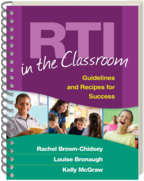RTI in the Classroom
Guidelines and Recipes for Success
Rachel Brown-Chidsey, Louise Bronaugh, and Kelly McGraw
- Present color-coded intervention recipes for all three tiers of RTI implementation.
- Provide hands-on tools and 50 reproducibles, with a large format and sturdy spiral binding for ease of use.
- Explain the core features of RTI and what they look like in action.
- Describe evidence-based instructional methods for reading, writing, math, and behavior.
- Show how to fit assessment and progress monitoring into the busy school day.
“This is not a book that teachers will just read and replace on the shelf—it will be marked with highlighters, sticky notes, and dog-eared corners! This book will encourage new teachers and energize returning ones by giving them practical tools to implement RTI in their classrooms today. Wonderful features include a tool to assist schools in taking the next steps towards implementing RTI, planning forms to track student progress, and specific intervention recipes for reading, writing, math, and behavior.”
—Brenda Whitaker, MA, Principal, Edgewood Primary School, Bloomington, Indiana
“This book is indispensable for teachers whose districts have implemented RTI. The strong focus on the essential components of RTI gives the reader a foundation of knowledge from which a successful RTI plan can be developed. The book describes research-based interventions in reading, writing, mathematics, and behavior. Chapters on instructional considerations for English language learners and the use of the DIBELS system are invaluable.”
—Joseph Gerard, MA, school psychologist/RTI coordinator, Matanuska-Susitna Borough School District, Alaska
“One of the best how-to books for RTI on the market. Written in teacher-friendly, jargon-free language, this book is a high-yield resource for veteran and novice implementers, offering ideas you can put into practice today to enhance RTI implementation at your school.”
—Amanda VanDerHeyden, PhD, Education Research and Consulting, Inc., Fairhope, Alabama
“Classroom teachers, literacy coaches, and principals will find this book helpful in planning for and implementing RTI. The recipes clearly outline how to develop multi-tiered, evidence-based interventions for struggling students. This would be an ideal text for professional development initiatives and teacher book clubs.”
—Christina Cassano, MEd, doctoral candidate and former classroom teacher and literacy specialist, Boston, Massachusetts
“Enlightening. This book offers a better understanding of how curriculum can work more efficiently in order to meet the needs of all students. I thoroughly enjoyed the book and look forward to training my staff on the implementation of RTI. Whether you are an administrator, teacher, professor, or graduate student, this book is a 'must read.'”
—Debbie Ferree, MS, Principal, Edgewood Intermediate School
“RTI in the Classroom has the ingredients to help teachers, psychologists, and school leaders understand and apply one of the most important recent advances in education. Designed to be practical and user friendly, this book delivers what it promises: pragmatic descriptions of key concepts along with helpful examples, valuable resources, and meaningful questions for reflection and implementation. Chapters review interventions not only for reading but also for writing, math and behavior, offering excellent suggestions for research-based best practices. The discussions of benchmarking and progress monitoring, as well as how to meet the needs of English language learners, are very helpful.”
—Blanche Podhajski, PhD, President, Stern Center for Language and Learning, Williston, Vermont; Department of Neurology, University of Vermont College of Medicine
Table of Contents
Introduction: What Is RTI, and Why Are They Telling Me to Do It?1. It Takes a Village: Building Consensus in School and at Home
2. How to Use the Tiered Framework
3. Evaluating the Core Curriculum: How Do We Know If It’s Working?
4. How Are the Kids Doing?: Progress Monitoring Is Not Optional
5. Yikes! I Have “Kids at Risk”: Don’t Worry—We’ve Already Done the Heavy Lifting for You
6. Reading Interventions
7. Written Language Interventions
8. Math Interventions
9. Behavior Interventions
10. RTI with English Language Learners: Instructional Considerations
11. If You’re Working in a DIBELS System, This Chapter Is for You
12. This All Sounds Great, but How Am I Supposed to Fit It into My Schedule?: Scheduling and Logistics
Appendix A. RTI Readiness Checklist
Appendix B. Reproducible Planning Forms
Appendix C. Intervention Recipes for Reading, Writing, Math, and Behavior
About the Authors
Rachel Brown-Chidsey, PhD, NCSP, is Senior Academic Officer for FastBridge Learning and a faculty member in the Department of Educational and School Psychology at the University of Southern Maine. Prior to obtaining her doctorate in school psychology, she taught middle and high school history and special education for 10 years. Her research areas include curriculum-based measurement, response to intervention (RTI), multi-tiered systems of support (MTSS), and scientifically based instruction methods. Dr. Brown is coeditor of Assessment for Intervention, Second Edition: A Problem-Solving Approach and coauthor of Response to Intervention, Second Edition: Principles and Strategies for Effective Practice;Louise Bronaugh, PhD, a school psychologist, is CEO of BEST Workshops for Educators, Eugene, Oregon. As a district-level literacy support specialist, she worked on the development and implementation of a schoolwide response-to-intervention model. Since 2004, Dr. Bronaugh has been conducting district-level trainings on Dynamic Indicators of Basic Early Literacy Skills (DIBELS) administration and scoring, customized districtwide DIBELS data interpretation, small-group literacy instruction, positive behavior support, and response to intervention. She has also taught in special education classes.
Kelly McGraw, PhD (now Kelly Broxterman), is Associate Professor at the Chicago School of Professional Psychology. Previously, she worked as a school psychologist and professional learning and leadership consultant at Heartland Area Education Agency in Johnston, Iowa, where she was responsible for using response to intervention to identify student needs and training teachers on district- and agencywide initiatives. She has presented nationally in the areas of data-based decision making, curriculum-based measurement, and effective instruction. Additional experiences include consulting with schools implementing response to intervention and working with teachers to improve the link between assessment and instruction. Her current efforts involve training students in educational foundations and systems change and consulting with school districts around the Midwest.
